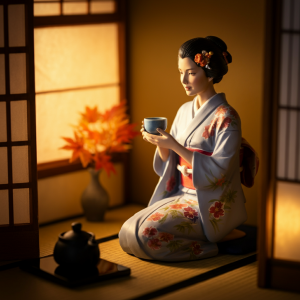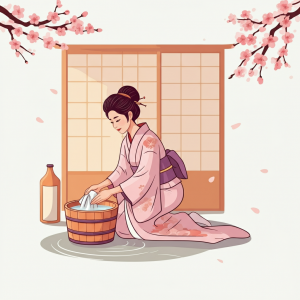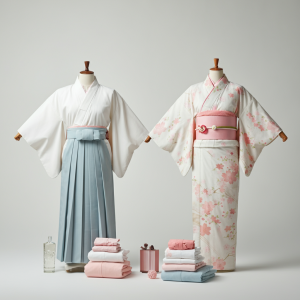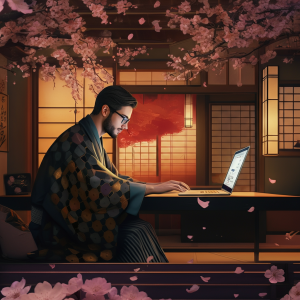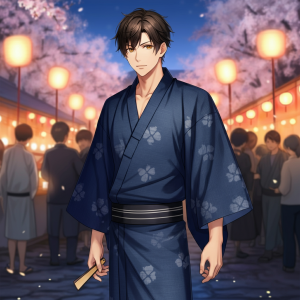The holiday season brings a special kind of magic into our homes. We decorate, we cook, and most importantly, we open our doors to friends and family. As a host, you likely spend weeks planning menus and activities to make your guests feel cherished. But what about the small, quiet moments in between the celebrations? Consider the simple act of providing a guest robe—a gesture that offers comfort and a touch of luxury.
This year, elevate that experience by swapping the standard terry cloth for something truly memorable: a Japanese kimono or yukata. More than just a robe, it’s a thoughtful detail that blends practicality with elegance. It shows your guests you’ve considered their comfort down to the last detail. This simple addition can transform their stay from a pleasant visit into a cherished memory, all while being surprisingly easy and affordable for you.
A Gesture of Unforgettable Hospitality
When guests arrive, they are often living out of a suitcase. Providing a dedicated robe for lounging is a classic sign of a thoughtful host. A kimono or yukata takes this gesture to the next level. Unlike bulky bathrobes, these garments offer a unique blend of style and comfort.
Imagine your guest finding a beautifully folded, crisp cotton kimono waiting for them in their room or the bathroom. It’s an unexpected touch of luxury that immediately makes them feel pampered and welcomed. This isn’t just about providing something to wear; it’s about creating an experience. The lightweight fabric and elegant design feel special, turning a simple morning coffee or a quiet evening into a more refined moment of relaxation. It’s a small detail that communicates a powerful message: “You are special to us, and we want you to feel completely at home.”
The Practical Elegance of Kimonos and Yukatas
While the aesthetic appeal is undeniable, the practicality of these robes is what makes them a perfect fit for a busy host. Many authentic kimonos and yukatas are designed for ease of use and durability.
Easy Care for Busy Hosts
One of the biggest advantages is how simple they are to maintain. Many are made from high-quality, machine-washable cotton. You can simply toss them in the wash with other linens after your guests depart, and they come out fresh and ready for the next visitor. This eliminates the need for special laundering or dry cleaning, saving you time and effort during a hectic holiday season. The crisp feel of the cotton is easily restored, ensuring every guest gets that “brand new” experience.
Yukata: The Ideal Lightweight Option
When selecting a robe, you will often encounter both kimonos and yukatas. While related, the yukata is particularly well-suited for home use. Traditionally worn in summer or at hot spring resorts, yukatas are unlined robes made of a lighter cotton. This makes them perfect for wearing indoors, where central heating keeps things cozy. Your guests won’t feel overheated, and the fabric is soft and breathable against the skin, making it comfortable for lounging any time of day.
Styling, Comfort, and Modesty
A common concern with any house robe is coverage. You want your guests to feel comfortable walking from the bedroom to the kitchen for a glass of water without feeling exposed. Japanese kimonos and yukatas excel in this regard.
Each robe comes with a matching sash or belt, known as an obi. This allows your guests to easily secure the robe for a comfortable and modest fit. The design provides ample coverage, making it appropriate for wearing around you and other family members. The fabric drapes elegantly without being clingy, offering a flattering silhouette for all body types. Your guests can relax in style, whether they’re enjoying a lazy morning or winding down after a long day of festivities. This built-in modesty ensures everyone feels at ease, contributing to a relaxed and welcoming household atmosphere.
A Gift That Lasts Beyond the Holidays
The versatility of a kimono robe extends beyond a single visit. As a host, you have a few wonderful options once your guests have gone home.
First, you can treat them as part of your regular guest linen collection. Their durability means they can be washed and stored, ready to welcome visitors for years to come. Building a small collection of two or three ensures you are always prepared for holiday visitors or unexpected weekend guests.
Alternatively, for a truly generous gesture, you can invite your guests to take their robe home as a keepsake. A beautiful yukata is a memorable and useful gift that they will treasure long after the holidays are over. Every time they wear it, they will be reminded of the wonderful time they spent with you. This turns a simple piece of guest comfort into a lasting symbol of your friendship and hospitality, making it a gift that feels both personal and luxurious.
Setting the Stage for a Warm Welcome
Presentation is key to making this gesture feel special. Instead of just hanging it in the closet, consider how to display the robe for maximum impact upon arrival.
You could lay it neatly folded at the foot of the guest bed, along with fresh towels. Or, for a spa-like touch, hang it on a beautiful hook on the back of the bathroom door. Placing it alongside a small basket of toiletries—like nice soap, lotion, or a sleep mask—completes the picture of a five-star welcome. This thoughtful staging takes only a few moments but sets the tone for a relaxing and enjoyable stay.
Prepare Your Welcome Today
The holiday season is a time for connection and creating joyful memories. The small, thoughtful details are often the things our loved ones remember most. By offering a beautiful kimono or yukata, you provide more than just a robe; you offer a unique experience of comfort, elegance, and care. Start preparing your home for the season now by selecting a few beautiful robes. It’s a simple, affordable way to make your holiday guests feel truly cherished. Chopa.com offers over 100 styles, patterns, colors, and sizes. Visit their online store, Kimono Shop, where shipping is quick and orders of $75 or more ship free.




